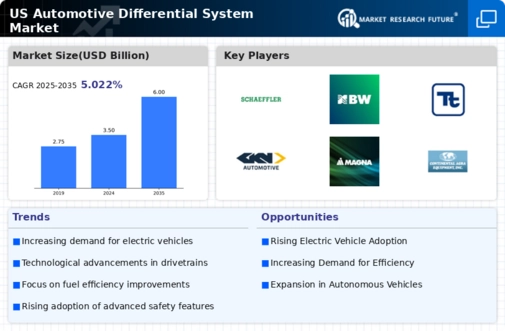The US Automotive Differential System Market is characterized by intense competition and rapid technological advancements, driving the demand for innovative and efficient differential systems in vehicles. This market serves a wide array of automotive manufacturers and aftermarket suppliers, with key players continuously striving to enhance performance, fuel efficiency, and overall driving experience through improved designs and materials. Differentiation strategies such as advanced engineering capabilities, research and development investment, and strategic partnerships are prominent among competitors as they seek to establish a strong foothold in this growing sector.
The increasing demand for electric vehicles and hybrid technologies is also reshaping the competitive landscape, as companies adapt their offerings to meet emerging consumer preferences and regulatory requirements.Schaeffler has established itself as a formidable presence in the US Automotive Differential System Market thanks to its strong focus on engineering excellence and innovation.
The company’s competencies in producing precision components and systems allow it to deliver solutions that enhance vehicle performance and efficiency. Schaeffler’s extensive experience in the automotive sector, combined with a robust supply chain network, enables it to respond swiftly to market demands and modifications. The company's product portfolio within the differential system realm includes advanced gear technologies and electronic components that contribute to improved drivability and reduced emissions.
Schaeffler’s emphasis on sustainability and commitment to research and development underscores its strengths in adapting to new trends, making it a competitive player in the market.BorgWarner is another key player in the US Automotive Differential System Market, recognized for its innovative solutions and comprehensive product offerings.
The company specializes in providing advanced powertrain technologies and solutions, with a distinctive emphasis on hybrid and electric vehicle applications that support the transition towards greener transportation. BorgWarner’s portfolio in the differential system space includes variable torque management systems and electric differentials, designed to improve traction and overall vehicle dynamics. The company's strategic mergers and acquisitions have bolstered its market presence, allowing it to expand its product capabilities and enhance its operational efficiencies.
BorgWarner's strengths are reflected in its industry leadership, consistent focus on innovation, and ability to cater to the evolving demands of the automotive market in the US, which favors suppliers who can deliver advanced technology combined with sustainable practices.



















Leave a Comment